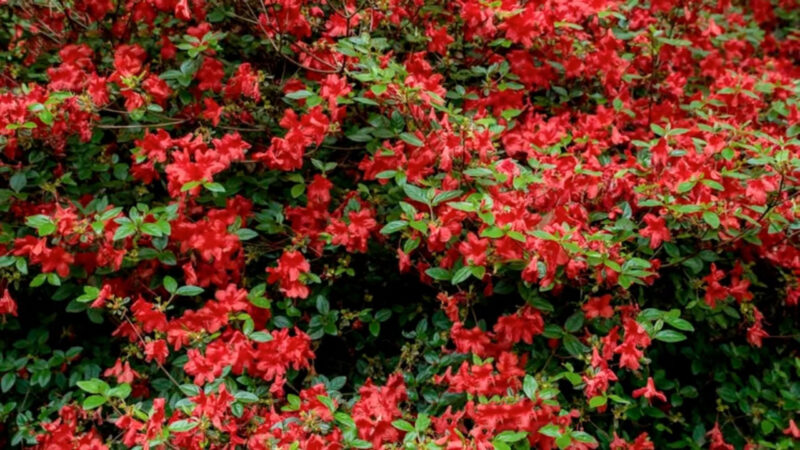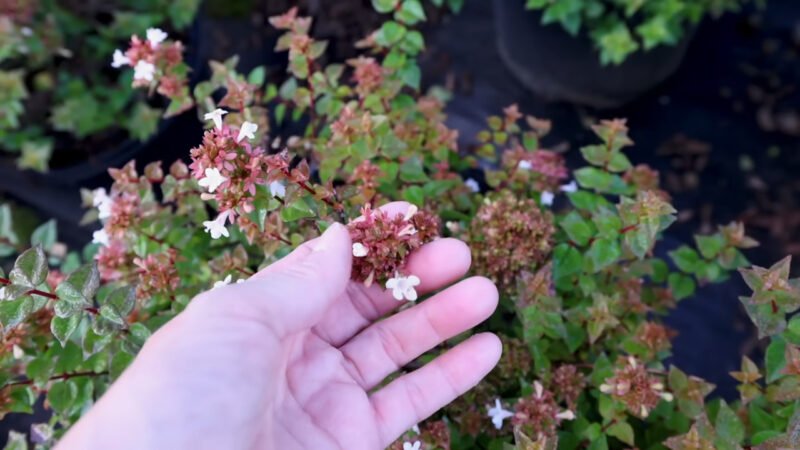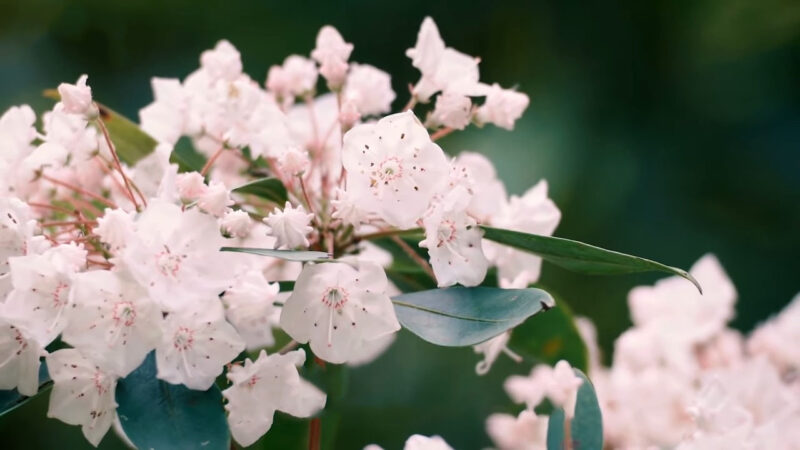Red evergreen shrubs are a vibrant choice for any gardener looking to add lasting color to their landscape. Unlike deciduous plants that lose their leaves in winter, these evergreen varieties maintain their foliage year-round, providing a constant backdrop of greenery.
The addition of red hues brings a splash of color that can make your yard stand out in any season. These plants come in many forms, from low-growing ground covers to towering hedges, and their rich red leaves or vibrant red berries can offer an attractive contrast against the traditional greens of a garden.
When choosing the right ones for your yard, it is essential to consider the climate, soil type, sunlight, and the level of care you can provide. These factors will influence not only which species will thrive in your garden but also how well they’ll contribute to the overall aesthetic and design of your outdoor space.
Many red evergreen shrubs also provide additional benefits such as privacy, wind protection, and even attracting wildlife. With proper selection and care, these beautiful plants can become the cornerstone of your garden’s design.
Another red plant that will make your garden vibrant is Rio Dipladenia. Easy to maintain and care for.
Key Takeaways
- Red evergreen shrubs provide year-round color and can enhance the overall aesthetic of a garden.
- It is important to choose shrubs that are suitable for the local climate and garden conditions.
- These shrubs offer functional benefits like privacy, wind protection, and attracting wildlife.
What to know About Red Evergreen Shrubs?
Red evergreen shrubs are essential components in landscaping, offering year-round color and structure. Their distinctive hues and enduring leaves provide both aesthetic appeal and functional benefits.
Defining Characteristics
Red evergreen shrubs are defined by their ability to retain leaves throughout the year—adding consistent color to gardens even during the colder months. Among their defining characteristics:
- Foliage: The leaves often showcase shades of red, ranging from deep maroon to bright ruby, sometimes changing intensity with the seasons.
- Red Berries: Many varieties also bear red berries, which can be particularly attractive against the winter backdrop and also provide food for wildlife.
Benefits in the Landscape
- Privacy: These shrubs can be planted as hedges or screens, offering a natural barrier that enhances privacy throughout the year.
- Landscaping: Incorporating red evergreen shrubs into foundation planting, as specimen plants, or within mixed borders contributes a bold color, contrast, and texture to the landscape.
- Gardeners often select them for both their aesthetic and practical qualities, such as low maintenance requirements and adaptability to various conditions.
By integrating these shrubs into garden designs, both novice and experienced gardeners alike can enjoy the striking appearance and utility that red evergreen shrubs bring to the landscape.
Selecting the Right Shrubs for Your Yard
Selecting the appropriate red evergreen shrubs for your yard hinges on understanding the specific climate, sunlight availability, and soil conditions. Each shrub species has unique requirements that enable it to thrive.
Considerations for Climate and Sunlight
- Climate: Shrubs vary in their ability to withstand cold and regional weather patterns. It’s essential to choose shrubs that are suited to the USDA Hardiness Zone in which one lives. For example, Red-tipped Photinia is well-suited for zones 7 through 9.
- Sunlight: Plants have different sunlight needs, ranging from full sun to shade. One must ascertain how much sunlight different parts of their yard receive throughout the day. A shrub-like Mountain Fire Pieris may require full sun to partial shade to flourish.
Soil Types and pH Preferences
- Soil Types: Different shrubs will adapt to various soil textures, from sandy to clay-heavy soils. It’s crucial to assess the soil type of your yard to ensure compatibility.
- pH Preferences: The acidity or alkalinity of soil can impact plant health. Most evergreen shrubs prefer slightly acidic to neutral pH levels. Soil pH testing kits are readily available and can guide one in either adjusting the soil pH to meet a plant’s needs or selecting shrubs that will thrive in the existing soil conditions.
Popular Red Evergreen Shrub Varieties

Red evergreen shrubs offer year-round color and texture to gardens. They range from the vibrant Rhododendrons to versatile Nandina cultivars, and other diverse shrubs, each with distinct characteristics and ornamental value.
Rhododendron Varieties
Rhododendrons are renowned for their vividly colored bell-shaped flowers which complement their evergreen foliage. Notable Rhododendron varieties include the Rhododendron catawbiense, which boasts beautiful purple flowers, and the Rhododendron ‘Nova Zembla’, known for its deep red blooms.
Azaleas, part of the Rhododendron family, also provide vibrant red hues and can range from larger shrubs to dwarf evergreen varieties, suitable for different garden sizes and styles.
Nandina and Its Cultivars
Nandina domestica, commonly known as Heavenly Bamboo, is not a true bamboo but an evergreen shrub valued for its foliage that turns reddish in winter. Its cultivars, such as the ‘Fire Power’ Nandina, maintain a compact size while displaying intense red foliage. For year-round interest, Nandina varieties often produce clusters of bright red berries, adding to their appeal.
Other Noteworthy Shrubs
A selection of evergreen shrubs, including Euonymus, Mahonia, Camellia, Leucothoe, and Pieris japonica, also offer red hues. For instance, the ‘Red Cascade’ Pieris is admired for its red young leaves and cascading racemes of flowers. Mahonia’s bold, spiny leaves turn reddish-purple in winter, while some Euonymus shrubs exhibit red foliage or berries.
‘Ruby’ Camellia stands out for its sumptuous red flowers that are a highlight in any garden, and the ‘Scarletta’ Leucothoe displays a brilliant red fall coloration, making these shrubs essential for a garden with year-round interest.
Planting and Care
Selecting the right time for planting and understanding the specific care requirements are crucial for the thriving of red evergreen shrubs in your yard. This section provides detailed insights into the best practices for planting and maintaining these vibrant additions to your landscape.
Best Time to Plant
The optimal planting season for red evergreen shrubs is typically early fall or spring when the extreme temperatures of summer and winter are not a threat. During these seasons, the cooler temperatures and typically more abundant moisture help the shrubs establish their root systems.
Some species, such as the Mountain Fire Pieris, should be planted when the soil temperature has stabilized to ensure the best growth conditions.
Initial Planting Guidelines
When planting red evergreen shrubs, selecting a place with correct light conditions—full sun to partial shade—is essential depending on the species. The shrubs prefer a location that can provide protection from harsh afternoon sun in regions with very hot summers.
- Soil Requirements: Well-drained soil is a must, as is ensuring the pH is suitable for your particular shrub variety.
- Planting Depth and Spacing: The shrub’s root ball should be level with the soil surface, and space between shrubs should accommodate their mature size.
- Watering: Initially, deep watering twice a week can be necessary, as indicated by instructions for plants like the ‘Mountain Fire’ Pieris.
Ongoing Maintenance
Red evergreen shrubs generally require regular but manageable care to thrive in a backyard setting.
- Pruning: Most red evergreens benefit from annual pruning to maintain their shape and encourage new growth with better foliage color. For instance, the Photinia × Fraseri ‘Red Robin’ should be pruned to encourage the bright red new leaves.
- Watering: Regular watering is particularly important during dry spells. Monitor the soil moisture and adjust your watering schedule accordingly.
- Fertilizing: An annual application of a balanced fertilizer in early spring can promote healthy growth and vivid foliage.
Implementing these specific guidelines ensures your red evergreen shrubs will be a standout feature in your landscape for years to come.
Design Ideas for Red Evergreen Shrubs

Red evergreen shrubs can dramatically enhance your garden’s aesthetics throughout the year. These versatile plants serve various design purposes, from creating vivid focal points to ensuring privacy and adding structure to patios and decks.
Creating Focal Points
Specimen plants like the ‘Mountain Fire’ Pieris, with its striking red foliage, excel at drawing the eye and anchoring landscape designs. Position these red evergreen shrubs within your garden as standalone features or to mark transitions within outdoor spaces.
Incorporating Shrubs in Borders
Utilize red evergreen shrubs as border plants to inject a perennial pop of color into garden beds. They can define the edges of landscaping and, when planted in a sequence, create a rhythm that guides the viewer’s gaze through the garden.
Using Shrubs for Privacy Screening
Red evergreen shrubs serve as an effective privacy hedge when planted in a line. These hedges can screen a garden from a road or neighboring houses, providing a lush and attractive barrier that’s more inviting than a fence.
Potting Shrubs for Patios and Decks
For those with limited space or hardscaped areas, use red evergreen shrubs as container plants. They can be potted to decorate patios or decks, allowing flexibility in moving the plants as needed, and adding texture and color to urban outdoor spaces.
Frequently Asked Questions
What are some recommended evergreen shrubs with red foliage suitable for full sun conditions?
For sunny areas, the Red-tipped Photinia is an excellent choice. It tolerates full sun and provides a vibrant red color. Additionally, the Fraseri ‘Red Robin’, with its dark red young foliage, thrives in full sun and matures to a deep green.
Can you suggest some low maintenance evergreen shrubs with red leaves for landscaping?
Junipers are recognized for their low maintenance needs and can offer attractive red coloration, especially certain varieties like the ‘Blue Point Juniper‘, which can develop bluish-red berries.
Which tall evergreen shrubs offer vibrant red colors throughout the year?
Mountain Fire Pieris is a striking tall evergreen that showcases vivid red new growth throughout the year, making it a captivating addition to any landscape.
Are there any compact evergreen shrubs that display red leaves suitable for small gardens?
Compact varieties such as the ‘Rhododendron Impeditum’ can offer beautiful red foliage while fitting into smaller garden spaces due to their reduced size.
How can I identify an evergreen bush that retains its red foliage all year?
One can identify an evergreen shrub with year-round red foliage by observing its leaves’ color during different seasons. The ‘Nandina domestica’ commonly maintains its red leaf color throughout the year.
Final Reflections
Adding red evergreen shrubs into your yard can significantly enhance its aesthetic appeal and provide year-round vibrancy. These shrubs not only offer a stunning display of red hues but also bring a sense of permanence and structure to your garden.
From the fiery tones of the Photinia to the deep reds of the Japanese Barberry, each shrub has its unique charm and characteristics.
When selecting red evergreen shrubs, consider factors like climate adaptability, maintenance requirements, and growth patterns to ensure they thrive in your specific environment. Remember, the key to a beautiful and healthy garden lies in understanding the needs of your plants and providing them with the right care.
Related Posts:
- What Is the Most Environmentally Friendly Pool?…
- How Do Red Foxes Survive Winter? Survival Guide
- Why Do Moths Eat Your Clothes? - Wardrobe Woes
- How to Layer a Compost Bin: Transform Your Waste into Gold
- How To Stop Raccoons Digging Up Your Lawn -…
- How to Reduce Your Pool's Environmental Impact - 2024 Guide








